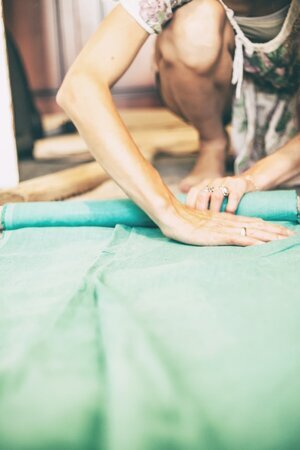Behind the Scenes of a Custom Drapery Workroom
Imagine a room that is warm and cozy with beautiful fabrics on soft furnishings throughout the space. Or a sleek and modern area with solar shades that block the glare of the sun off the lake but still allow filtered light into the room. Or maybe even a rustic cabin with woven wood shades that pull out the warm colors of the hardwood floors.
Finished spaces that are comfortable, welcoming, and beautifully decorated don't happen by chance or overnight or come from a big box retailer. Interior designers spend hours pulling together the right color pallet, furnishings and window treatments that fit their clients needs, personality, and how they live in a space. Custom window treatments can play a huge role into reaching the desired outcome of the room. There are many benefits of custom window treatments and much that goes into making a custom product.
Custom Window Treatments vs. Retail: What's the Difference?
There are so many differences between off the rack and custom window treatments. When you hear "custom window treatment" you probably think of products that are a combination of expensive fabrics, expensive hardware and hand sewn techniques. Although those are custom options, it does not always mean just those things. Custom means getting a product that fits perfectly in with the overall design. It means that the treatments fit the size of the window, that the panel length goes all the way to the floor, and that it will be fabricated to last for years to come. Yes, custom will cost more than a retail option. But you will not have the complete control over all the aspects (fabric design, color, perfect fit) that you get when you choose to use a window treatment specialist. I have had many clients who started with a retail option but quickly realized that what they wanted could not be found in a ready made product.
Custom treatments should be looked at as an investment in your home. Much goes into producing a quality window treatment which does mean that they will cost more than a retail item. But the difference in quality and longevity are well worth the investment. In the next few paragraphs you can see the all the effort it takes to make a custom window treatment.
Step 1. Window Treatment Consultation
After a brief phone consult to discuss the client's basic wants and needs, a meeting takes place to gather measurements, come up with a design concept, choose fabrics and hardware, and hard treatments. Needs such as privacy, light control, energy efficiency are just as important and in some cases more important than aesthetics. It is also the time to make sure that the desired treatment will work with the specifications of the windows. All these decisions need to be made in order to move forward with determining yardage and completing pricing for the project.
Step 2. The Raw Goods
Once the all the details are finalized and approved at that point fabric, trim, linings, etc. are ready to be ordered. Once those materials arrive they are inspected for correct yardage and to make sure they are free of flaws. Fabric and trim can often take several weeks to receive. If the fabric happens to be out of stock and is back ordered that will add additional time to the entire project. Some fabrics and trims are not produced in the United States which means there could be additional shipping expenses as well as additional time for them to reach the workroom. All materials must be present before fabrication can begin.
Step 3. Quality Inspection
Once all raw goods are received, they will be checked to confirm the yardage is accurate. Inspection of the fabric is so very important. A light is used to shine through the fabric to better see any flaws and repeats are measured from selvage to selvage to ensure the print does not drift/drop which makes it difficult to match the pattern at the seams. If there are issues they must be addressed before anything is cut off the bolt of fabric. Once the fabric or trim is cut it can not be returned to the mill.
Step 4. Pattern Placement & Cuts
When fabrics have a pattern it is important to look at it and determine which part should be at the top of the panel or centered on the front of the valance. It can be a personal preference and often times the designer will need to be consulted for the final decision as to what part of the material is to take center stage. Once those decisions are made, it is a good idea to plan out your cuts before actually taking scissors to fabric! If there is not enough material to complete the project with the chosen pattern placement, adjustments may need to be made or more fabric ordered.
Step 5. Tabling
Once pieces are cut it is time to table them. Tabling means layering the pieces so that they can be put accurately together and ready to be sewn. Lots of checking for final measurements for width and length occur during this stage as it is the final time to make changes before sewing everything together.
Step 6. Sewing & Stitching
Sewing is more than just running the fabric through the machine. Stitch length and thread tension needs to be adjusted so that the fabric does not pucker as it is sewn. Sometimes it is necessary to hand baste or glue baste the seams so that patterns match at the seams. Basting is then removed after the main machine stitch is put in. Depending on where trim is to be applied it may be machine sewn on by machine or by hand .
Step 7. Folding
Fan folding vs flat folding is mostly a personal preference. Some fabrics travel and install better if fan folded. Others may need to be flat folded depending on the type of pleat in a panel or in order to minimize creases in the fabric. Designers and workroom also may prefer one method over the other.
Step 8. Packaging with Love
Once products are completed, we take great care packaging so that treatments are protected. Wrapping and sealing the treatments in plastic keep dust and dirt from away and the treatments and in pristine conditions when they arrive for install.
Step 9. Delivery and Installation
Delivery and installation can look differently for each client. We can set up the installation with one of our professional installers and deliver the treatments on the day of install or designers/clients are welcome to pick up the treatments from us and schedule their own installation. Before the installation takes place it is important to remove all furniture from around the install area. Our installers are bonded and insured and will adhere to all professional and safety standards. We can also provide you with instructions on how to clean and care for your window treatments.
What would your most beautiful home look like?
Every treatment we produce is made with the upmost attention to detail. We love what we do and we love being able to make beautiful items that make others happy. Not only do you get a piece that fits your decor it is also specially fitted to your window and addresses your privacy needs. It is how we ensure that beauty and function work seamlessly together.
Custom window treatments make a huge difference in how you view and live in your space. They are worth the investment made in fabrics, professional workmanship, beautiful hardware and proper installation and will enhance your home for many years to come.
Ready for custom window treatments that will make you fall in love with your home again? We're here to help. Contact us to start your consultation.
Until next time,
Amanda










